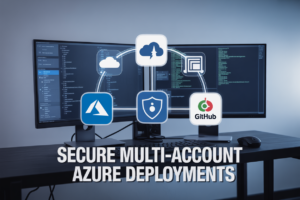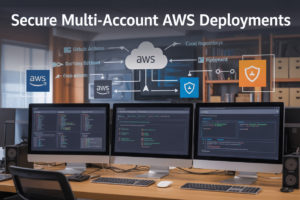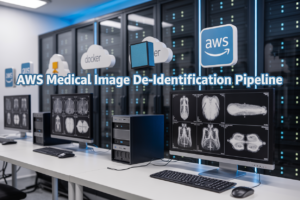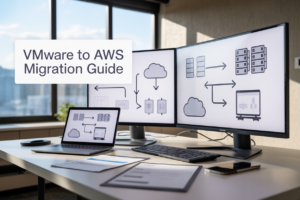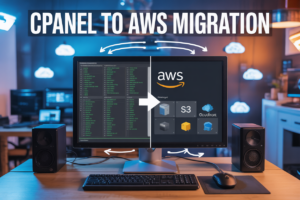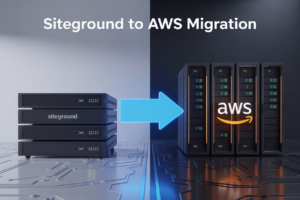You’re staring at your computer in utter disbelief. The email you just received confirms it: your company failed its CMMC assessment due to cloud security gaps. Thousands of dollars and months of work down the drain.
This scenario keeps defense contractors awake at night. But it doesn’t have to be your reality.
GCC High and AWS have become the power couple of compliant cloud hosting for defense contractors navigating DFARS and CMMC requirements. When properly implemented, these platforms create a fortress around your controlled unclassified information while maintaining operational efficiency.
But here’s where most companies go wrong – they assume compliance equals security, or that AWS alone checks all the CMMC boxes. The truth is far more nuanced, and the penalties for getting it wrong are steeper than you might think.
Understanding GCC High and AWS Compliance Frameworks
What is GCC High and why it matters for defense contractors
Defense contractors have a massive problem: they need secure cloud environments that meet strict government standards. Enter GCC High.
GCC High (Government Community Cloud High) is Microsoft’s specialized cloud environment designed specifically for defense contractors and federal agencies handling controlled unclassified information (CUI) and subject to ITAR regulations.
Think of GCC High as the Fort Knox of cloud environments. It’s built from the ground up to satisfy the Department of Defense’s stringent security requirements while giving contractors the Microsoft tools they need.
Why should defense contractors care? Simple. If you’re handling CUI or working on DoD contracts, using standard commercial cloud environments puts you at risk of non-compliance. That means potential contract loss, fines, or worse. GCC High provides the compliance foundation you need without sacrificing functionality.
AWS GovCloud: Features and security capabilities
AWS GovCloud isn’t just regular AWS with a government name slapped on it. It’s a completely isolated region designed for sensitive workloads subject to FedRAMP High and DoD security requirements.
The standout features include:
- Physical separation from commercial AWS regions
- US-persons-only access controls
- FIPS 140-2 validated cryptography
- Comprehensive compliance with ITAR, DFARS, and DoD requirements
- Enhanced monitoring and logging capabilities
What makes AWS GovCloud perfect for defense work is how it combines enterprise-grade cloud services with ironclad security controls. You get the scalability and innovation of AWS while maintaining the compliance posture required for defense contracting.
DFARS compliance requirements explained
DFARS 252.204-7012 sounds like boring regulatory code, but it’s actually the key to doing business with the DoD. This clause requires contractors to:
- Implement NIST SP 800-171 security controls
- Report cybersecurity incidents within 72 hours
- Flow down requirements to subcontractors
- Store and process CUI only in approved environments
The trickiest part? DFARS doesn’t just care about your technical controls. You need documented policies, training programs, and incident response procedures. Many contractors focus only on technical boxes to check, missing the broader security program requirements.
CMMC levels and certification process
The Cybersecurity Maturity Model Certification (CMMC) takes DFARS compliance and turns it into a verifiable framework with five distinct levels:
| Level | Description | Typical Requirement |
|---|---|---|
| Level 1 | Basic Cyber Hygiene | Federal contract information |
| Level 2 | Intermediate Cyber Hygiene | Transition step to Level 3 |
| Level 3 | Good Cyber Hygiene | CUI and controlled defense information |
| Level 4 | Proactive Practices | Critical programs and technologies |
| Level 5 | Advanced/Progressive | Highest sensitivity programs |
The certification process involves assessment by authorized third-party organizations. Unlike self-attestation models, CMMC requires actual verification of your security practices.
Most defense contractors will need Level 3 certification at minimum, which aligns with NIST SP 800-171 requirements plus additional process maturity.
Benefits of Integrating GCC High with AWS
Enhanced data sovereignty and protection
When you combine GCC High with AWS, you’re getting the ultimate security power couple. Think of GCC High as the specialized bodyguard for your sensitive data, while AWS provides the fortress with reinforced walls.
This integration gives you true data sovereignty – you know exactly where your information lives, who can access it, and under what conditions. Your sensitive defense data stays within US borders, handled only by screened US personnel.
The cool thing? AWS’s infrastructure was built from the ground up with security in mind. When you layer GCC High’s specialized controls on top, you get defense-grade protection that commercial solutions simply can’t match.
Meeting strict regulatory requirements
Compliance isn’t optional in the defense world – it’s mandatory. The GCC High and AWS combo is specifically engineered to meet DFARS, CMMC, ITAR, and other alphabet soup regulations that keep defense contractors up at night.
AWS brings FedRAMP High authorization to the table, while GCC High adds the specialized Microsoft security controls required for defense workloads. Together, they check all the boxes auditors are looking for.
What this means for you: less time stressing about compliance gaps and more time focusing on your actual work. The compliance capabilities are baked into the platform, not bolted on as afterthoughts.
Scalability while maintaining compliance
Here’s the dilemma most defense contractors face: how do you scale up without breaking compliance?
Traditional systems force you to choose between growth and security. The GCC High + AWS integration eliminates this false choice. Need to handle more data? Spin up new compliant resources in minutes. Project ending? Scale down just as quickly.
The beauty of this setup is that compliance scales automatically with your infrastructure. New systems inherit the same robust security controls, whether you’re managing 10 documents or 10 million.
Cost-effectiveness compared to on-premises solutions
Let’s talk money. On-premises compliance solutions are budget-killers:
- Hardware costs that depreciate the moment you install them
- Specialized security personnel commanding premium salaries
- Constant updates and patches eating into operational time
- Overprovisioning “just in case” capacity that sits idle
The GCC High and AWS model flips this equation. You pay for what you use, when you use it. No more massive capital expenditures or maintaining physical infrastructure that’s obsolete in three years.
The savings are substantial – typically 30-50% compared to maintaining equivalent compliant infrastructure in-house.
Improved operational efficiency
Time is money, especially in the defense sector. The GCC High and AWS integration streamlines operations in ways that transform how your team works:
- Automated security patches and updates happen behind the scenes
- Provisioning new compliant environments takes minutes instead of months
- Security monitoring runs 24/7 without requiring your direct attention
- Documentation for audits is generated automatically in many cases
Your teams can focus on mission-critical tasks instead of babysitting infrastructure or scrambling to prepare for audits. The result? Faster delivery, reduced overhead, and happier teams who can concentrate on innovation rather than compliance paperwork.
Implementation Strategies for Secure Cloud Hosting
A. Step-by-step migration approach
Moving to a GCC High and AWS environment isn’t something you tackle overnight. Smart organizations break it down into manageable chunks:
-
Assessment Phase
- Inventory your current systems and data
- Classify information by sensitivity level
- Identify DFARS/CMMC requirements applicable to your organization
-
Planning Phase
- Define security boundaries
- Select appropriate AWS services that meet compliance requirements
- Create a timeline with minimal operational disruption
-
Implementation Phase
- Start with non-critical workloads
- Migrate in stages, validating compliance at each step
- Implement security controls from the ground up
-
Testing Phase
- Run parallel systems before full cutover
- Conduct security scanning and penetration testing
- Verify all CMMC controls are functioning
B. Security configurations and best practices
The devil’s in the details when configuring your cloud environment:
-
Identity Management
- Implement multi-factor authentication across all access points
- Use role-based access with least privilege principles
- Enforce strong password policies and rotation schedules
-
Network Security
- Deploy AWS Security Groups as virtual firewalls
- Use Virtual Private Clouds (VPCs) with proper segmentation
- Implement encrypted VPN connections for all remote access
-
Data Protection
- Encrypt data both in transit and at rest
- Implement key management that meets CMMC requirements
- Set up backup and disaster recovery with appropriate controls
-
Continuous Monitoring
- Deploy AWS CloudTrail for comprehensive audit logging
- Set up alerting for suspicious activities
- Regular review of security posture with automated tools
C. Documentation requirements for compliance audits
Auditors love paperwork, and DFARS/CMMC compliance demands it:
-
System Security Plan (SSP)
- Comprehensive description of all system components
- Detailed mapping of implemented controls to CMMC requirements
- Clear documentation of security boundaries
-
Configuration Management
- Baseline configurations for all system components
- Change management procedures and approvals
- Version control for all security-relevant documentation
-
Incident Response Plan
- Documented procedures for security incidents
- Contact information for response team members
- Evidence of regular testing and updates to the plan
-
Assessment Results
- Reports from vulnerability scans
- Penetration test results and remediation plans
- Self-assessment documentation against CMMC controls
Keep your documentation current and easily accessible. Nothing tanks an audit faster than outdated or missing documentation when an auditor comes knocking.
Technical Security Controls in GCC High and AWS
A. Encryption mechanisms and key management
Look, securing sensitive defense data isn’t optional when you’re dealing with DFARS and CMMC requirements. Both GCC High and AWS know this game well.
Microsoft GCC High offers encryption across the board – your data at rest, in transit, and even while it’s being processed. They use AES-256 encryption (military-grade stuff) and manage the encryption keys through their Key Vault service. What’s neat is that you can bring your own keys if you’re the untrusting type.
AWS isn’t playing around either. Their Key Management Service (KMS) lets defense contractors handle encryption keys like the precious assets they are. With AWS CloudHSM, you get dedicated hardware security modules that make sure your keys stay yours and yours alone.
The real difference? GCC High’s encryption is baked right in, while AWS gives you more customization options but requires more setup on your end.
B. Access control and identity management
Getting access control right can make or break your compliance status.
GCC High leverages Azure Active Directory for Government, which is physically separated from commercial Azure. This gives you:
- PIV/CAC card integration for that sweet two-factor authentication
- Conditional access policies based on device, location, and risk factors
- Privileged Identity Management to limit admin access
AWS offers Identity and Access Management (IAM) with fine-grained permissions that would make a security officer smile. Their AWS Organizations service helps create permission boundaries between different project environments, which is crucial when working on multiple defense contracts.
C. Continuous monitoring solutions
Defense contractors can’t afford to take their eyes off the ball. Period.
GCC High includes Microsoft Defender for Cloud (formerly Azure Security Center) that constantly scans for vulnerabilities and misconfigurations. Their Secure Score feature shows exactly where your security stands and what needs fixing.
AWS brings GuardDuty to the table, which uses machine learning to spot suspicious activities. AWS Security Hub then centralizes all your security findings in one dashboard, so you’re not jumping between screens when seconds count.
Both platforms offer robust logging capabilities, but AWS CloudTrail captures a more comprehensive audit trail for forensic investigations.
D. Incident response capabilities
When (not if) something happens, how quickly can you respond?
GCC High’s Microsoft Defender for Cloud includes automated investigation capabilities that can contain threats before they spread. Their incident response playbooks help streamline your reaction to common security events.
AWS’s Security Incident Response Guide provides a framework, but their Detective service is where the magic happens. It collects data from multiple sources to help you identify the root cause of security issues faster than manually piecing together logs.
The real win for defense contractors is integrating these tools into your existing incident response procedures. Both platforms offer APIs that allow you to automate responses to common security events, cutting your reaction time from hours to minutes.
Real-World Applications and Success Stories
A. Case study: Small defense contractor implementation
Meet FrontLine Defense Solutions, a 50-person shop that was drowning in paperwork trying to maintain DFARS compliance. Their IT team? Just two overworked people.
They implemented GCC High for Microsoft services and AWS GovCloud for their specialized applications. The transition took 3 months—not the 6+ they feared.
The game-changer? They didn’t have to build separate security controls for different systems. AWS and GCC High’s pre-built compliance frameworks meant 80% of their CMMC requirements were addressed out-of-the-box.
“We stopped losing sleep over audits,” says their CIO. “And stopped losing contracts because of compliance concerns.”
B. Enterprise-level deployment examples
Larger defense contractors face different challenges. Take MetaSys Defense Corp with 3,000 employees across 12 states.
They deployed a hybrid solution:
- GCC High for daily operations and communication
- AWS for secure DevSecOps and classified project environments
- Custom integrations between both platforms
Despite their size, they completed migration in 9 months. The cloud platforms automatically handled updates to compliance requirements—something that previously required a dedicated team of 5 full-time employees.
C. ROI and compliance benefits achieved
The numbers don’t lie:
| Metric | Before Cloud | After GCC High + AWS |
|---|---|---|
| Annual compliance costs | $250K-1.2M | $80K-400K |
| Time to implement new controls | 3-6 months | 2-4 weeks |
| Documentation time | 120+ hours/month | 30 hours/month |
| Failed audit points | 12-20 annually | 0-3 annually |
Most contractors report 60-75% reductions in compliance management overhead and nearly eliminated emergency remediation costs.
D. Lessons learned and best practices
Companies that succeed with GCC High and AWS don’t just “lift and shift.” They:
- Start with a thorough data classification exercise
- Adopt a “compliance-as-code” mindset, automating security checks
- Train teams before migration, not during
- Implement in phases, not all at once
- Partner with specialists who understand both platforms
The biggest mistake? Treating GCC High and AWS as separate environments rather than complementary systems. The magic happens when they work together.
Navigating DFARS and CMMC compliance requires robust cloud hosting solutions that prioritize security without compromising functionality. By integrating GCC High with AWS, organizations can leverage the specialized compliance frameworks of Microsoft’s government cloud alongside AWS’s comprehensive security controls. This powerful combination enables defense contractors and federal agencies to implement technical safeguards that protect controlled unclassified information while maintaining operational efficiency.
The path to compliance doesn’t need to be overwhelming. With proper implementation strategies and security controls, your organization can join the ranks of successful GCC High and AWS adopters who have streamlined their compliance journey. Take the first step today by assessing your current infrastructure against CMMC requirements and exploring how these secure cloud hosting solutions can transform your compliance posture while supporting your mission-critical operations.













